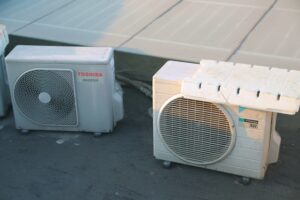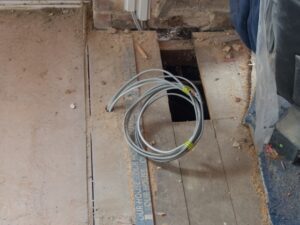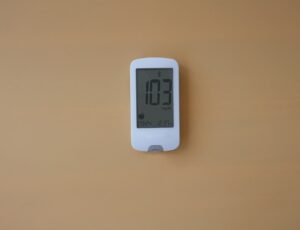When the freezing winter chill sets in, dealing with a frozen sewer line can be a nightmare. It’s one of those plumbing issues that can really disrupt your day-to-day activities, isn’t it?
So, what can you do when your sewer line freezes?
One of the simplest solutions is to use hot water to flush out the clog if only a small section is blocked. If the blockage is a bit more severe, using a space heater or heat lamp can help get the job done. For those particularly stubborn areas, wrapping the pipe with heat tape can make a noticeable difference by providing consistent heat directly to the frozen section.
But sometimes, despite these DIY efforts, the problem just doesn’t budge. That’s where the experts at Excel Mechanical come in!
Offering top-notch HVAC and plumbing services, we are well-equipped to handle both residential and commercial needs. Our team of professionals ensures that your plumbing system is functioning at its best—quickly, efficiently, and with exceptional value.
So, whether you’re looking to troubleshoot the issue yourself or want to rely on the pros for a guaranteed solution, we are here to offer the support you need!
In this blog, you will learn:
- The best methods for thawing your sewer line
- How to safely handle frozen pipes without causing damage
- When to call in professionals for help
Let’s get started!
Understanding Sewer Lines
Sewer lines play a crucial role in your home’s plumbing system.
They transport waste and wastewater from your home’s drains to the municipal sewer system or a septic tank. Understanding how sewer lines function can help you maintain them and address any potential issues.
Key Components
- Main Sewer Line: This is the primary pipe that carries sewage out of your home.
- Branch Lines: Smaller pipes that connect various drains in your home to the main sewer line.
- Trap: A curved section of pipe that prevents sewer gases from entering your home.
Common Issues
Sewer lines can face issues like blockages, leaks, or freezing.
Blockages often result from waste build-up, while leaks can be caused by pipe corrosion or damage. Frozen sewer lines happen in cold weather, leading to significant plumbing challenges.
Maintenance Tips
Regular maintenance of sewer lines is vital.
Flushing only appropriate items down the drain and considering professional inspections can prevent major problems. During colder months, ensure pipes are insulated to reduce freeze risks.
Our team provides reliable service to keep your sewer lines functioning smoothly, whether for home or business.
Safety Precautions
When trying to unfreeze a sewer line, taking care of yourself and the environment is important.
You need to protect yourself from potential hazards, and consider the effects certain methods may have on the surroundings.
Here are some safety precautions:
Personal Protection
When dealing with frozen sewer lines, it’s vital to use protective gear.
- Wear gloves to avoid direct contact with any chemicals or contaminated water that may spill.
- Safety goggles protect your eyes from splashes.
- Make sure to have sturdy, waterproof boots to prevent slipping on icy surfaces.
- If you are using electrical devices like a hair dryer for thawing pipes, ensure the area is dry to avoid electric shock.
- Keep a safe distance from chemicals or heating tools as they can be hazardous.
- Having a first aid kit nearby is advisable in case of minor injuries.
Environmental Considerations
Protecting the environment is important when you work on frozen sewer lines.
Avoid using harmful chemicals that can get into the ground or water supply. Some substances, like antifreeze, are environmentally harmful and should not be applied to sewer lines.
A more eco-friendly way is to use hot water or warm towels to gradually melt the ice, which is less harmful to the surroundings.
Identifying the Freeze
When dealing with a frozen sewer line, it’s important to locate the blockage and use the right tools to diagnose the issue effectively.
Knowing these steps can help in quick resolution and prevent further damage.
Let’s get started!
Locating the Blockage
Start by checking for signs of frozen pipes, such as reduced water flow or gurgling sounds from drains. These indicate where the blockage might be.
Look at areas vulnerable to cold, such as exterior walls or unheated spaces, as pipes here are more likely to freeze.
Examine any visible pipes for frost buildup, as this suggests freezing. If the blockage isn’t obvious, consider where the pipes might bend or narrow, since ice often forms in these spots.
House blueprints, if available, can help trace the path of your sewer lines.
Diagnostic Tools
Using the right tools can make identifying a freeze quicker.
A pipe thermometer can measure temperatures along the pipes, pinpointing colder, frozen sections. Thermal imaging cameras are also useful as they display temperature variations visually, helping you detect the freeze spot without dismantling walls.
You can also use audio detectors to listen for unusual sound patterns in the pipes. These changes often hint at blockages. For a more hands-on approach, slowly running warm water and checking flow rates at different points can highlight where the freeze is.
Preparation for Thawing
To successfully thaw a frozen sewer line, proper preparation is essential.
This involves accessing the sewer line carefully, gathering the right equipment, and going through a thorough pre-thawing checklist to ensure safety and efficiency.
Here is how you can prepare:
Accessing the Sewer Line
Accessing your sewer line requires knowing its location both inside and outside your home.
Locate access points such as cleanouts or inspection caps. These are typically found in basements, crawl spaces, or outside near the foundation.
Make sure the area is clear and safe from hazards like slippery surfaces.
Gathering Necessary Equipment
Gathering the right equipment is crucial for a successful thaw.
Some common items include a portable heater, heat lamp, warm towels, and buckets. Additionally, you might need rubber gloves and waterproof clothing to stay dry and protected. Having a thermometer can help monitor temperature changes in the line.
If the frozen section is inaccessible or severe, professional tools like heat tape or pipe thawing machines may be necessary.
Pre-Thawing Checklist
Before beginning the thawing process, make sure to inspect your plumbing system.
Look for visible cracks or leaks in pipes. Ensure that all nearby electrical outlets and other hazards are secured or moved away. Test the nearby faucets to confirm they are turned off.
Check your area for potential exposure to harmful elements, like carbon monoxide, if using fuel-based heaters. Consider notifying your plumber if there are hidden concerns or if the problem seems complex.
Following this checklist will ensure a safe thawing process, minimizing potential damage to your sewer line.
Thawing Techniques
Unfreezing a sewer line requires specific techniques to restore functionality.
You will learn about using hot water, applying heat lamps, electrical wire methods, and how steam is an effective tool.
Here are some effective thawing techniques:
Hot Water Method
When facing a frozen sewer line, using hot water is one of the simplest solutions.
Start by pouring hot water directly into the drain.
Be careful not to use boiling water, as it can damage your pipes. If the blockage is deep, attach a nozzle to a garden hose and feed it into the line. Once connected, gradually pour hot water through the hose into the sewer line.
This method helps melt ice by applying heat directly to the blockage. It’s most effective when you can access the clog easily. If the blockage persists, you may need to try additional methods.
Heat Lamp Application
A heat lamp can be an effective tool for thawing a sewer line in places that are difficult to reach.
Position the lamp to provide direct heat to the area where the pipe is frozen. Ensure the lamp is placed safely to avoid causing any damage to the surrounding surfaces.
Heat lamps work best in enclosed spaces, like basements or crawl spaces. Make sure to monitor the lamp and the pipe while the heat is applied. This method may require more time, depending on the thickness of the ice buildup.
Electrical Wire Method
Using electrical wire involves attaching a heated cable to the pipe’s exterior. These cables, often referred to as heat tapes or heat cables, provide consistent heat along the length of the area.
The installation usually involves wrapping the cable around the pipe, starting from a safe power source. Be sure to follow the manufacturer’s guidelines for proper usage. Electrical wire methods are advantageous in preventing future freezing as well.
Remember to consult professionals when necessary, as handling electrical components can pose safety risks.
Steam Thawing Procedure
Steam thawing is a powerful method for more severe blockages.
It involves using a steam-generating machine to channel steam through hoses into the affected sewer line. This process gradually melts the ice, clearing the pathway.
Steam is particularly effective because it reaches areas where water or heat lamps cannot. Professional equipment is typically required, so contacting an experienced service provider is recommended.
This method ensures you get the right professional touch for your needs, whether residential or commercial.
Preventive Measures
To minimize the risk of frozen sewer lines, regular maintenance, effective insulation, and careful temperature management are key. These actions ensure your plumbing system functions smoothly, even in cold weather.
Routine Maintenance
Regular upkeep is essential to preventing frozen sewer lines.
Start by having your plumbing inspected annually to identify any potential issues. Clearing drains and pipes of debris can help improve water flow and reduce blockages. Also, consider scheduling a professional sewer line cleaning. Removing build-up and sludge ensures that wastewater moves freely.
Act promptly if you notice slow drainage or unusual odors. These could be signs of blockages that may freeze when the temperature drops.
By maintaining your pipes, you protect your home from costly damages.
Insulation Practices
Proper insulation is crucial in preventing pipes from freezing.
Start by insulating any exposed pipes with foam sleeves or heat tape, focusing on particularly vulnerable areas such as basements and crawl spaces. Also, check the insulation in walls and attics where plumbing is located.
Seal any drafts around doors, windows, and light fixtures that may let in cold air. Pay particular attention to pipes on exterior walls.
You significantly reduce the risk of freezing by preventing cold air from reaching your plumbing.
Temperature Regulation
Maintaining a consistent temperature in your home can help prevent frozen lines.
Keep your thermostat at a minimum of 55°F, even when you’re away. This ensures that pipes within and under your home remain at a safe temperature.
During extreme cold, allow faucets served by exposed pipes to drip slightly. This keeps water moving and prevents it from freezing. Open cabinet doors under sinks to allow warm air to circulate around the plumbing, especially in kitchens and bathrooms.
Professional Assistance
When your sewer line is frozen, seeking professional help ensures safe and efficient solutions. Attempting to fix complex plumbing issues on your own can lead to more damage.
Hiring experts like Excel Mechanical is key for resolving these challenges. Our skilled technicians can quickly diagnose and address the problem, ensuring your sewer line is restored without risking further issues.
Here are some benefits of hiring a professional:
- Expertise: Professionals have the knowledge and tools to handle frozen sewer lines effectively.
- Safety: Attempting DIY methods can be risky. Experts ensure the job is done safely.
- Efficiency: Pros can resolve the issue faster than typical home remedies.
By choosing professional assistance, you save time, avoid potential hazards, and ensure the longevity of your plumbing infrastructure.
Summary
When dealing with a frozen sewer line, consider a few methods to resolve the issue.
Hot water can be effective if the blockage is near the pipe’s entrance. Simply flush the line with warm water to help melt the ice. Warm towels can also aid in thawing. Wrap them around exposed pipes. This method is gentle and gradually melts ice without causing damage.
A heat tape can be useful for a more robust solution. Wrap it around the frozen section for better heat distribution. This provides consistent warmth to the pipe.
To prevent further freezing, keep a small stream of water running from a tap. This helps maintain water flow and discourage ice buildup in partially thawed areas. A space heater or heat lamp can also help thaw out the ice. Ensure safety precautions are followed to avoid any hazards.
Excel Mechanical is your go-to solution for any HVAC or plumbing challenge. Our team offers exceptional quality and great value, ensuring each system meets your needs and budget.
Frequently Asked Questions
When it comes to thawing frozen sewer lines, plenty of questions arise. From preventing future freezing to knowing when to seek professional help, it’s crucial to understand the best practices. Here are some of the most common questions we get asked:
What steps should be taken to prevent sewer lines from freezing?
To prevent your sewer lines from freezing, run a small stream of water through your taps. This keeps the water moving and helps to prevent ice from forming. Also, remember to clear snow away from outdoor drains and septic tanks.
How does heat tape work to protect pipes against freezing?
Heat tape provides controlled warmth to pipes, helping to prevent them from freezing. It wraps around the pipe and maintains a consistent temperature. This method effectively exposes pipes in unheated areas and keeps them safe during cold weather.
At what temperature should you start taking precautions to avoid sewer line freeze-ups?
Take precautions when temperatures fall to 20°F (-6°C) or lower. At this point, pipes are at a higher risk of freezing, so it’s wise to employ measures like running taps, using heat tape, and insulating exposed pipes to minimize risk.
What are the risks of using salt to melt ice in frozen plumbing?
Using salt can corrode pipes and cause further damage. While salt lowers the freezing point of water, it might not be safe for your plumbing system. Consider safer methods like warm water or specialized thawing equipment instead of salt.
What safe household items can be used to thaw a frozen sewer pipe?
Warm water or hot towels can thaw a frozen sewer pipe. Pour gently or wrap the towels around the pipe to gradually melt the ice. These items are effective and pose less risk to your plumbing than harsher methods.
How can you tell if your sewer line is frozen?
Signs of a frozen sewer line include slow drains, strange smells, or gurgling noises from pipes. You might also notice a lack of water flow. Check for frost on exposed pipes as a clear indication of freezing.




